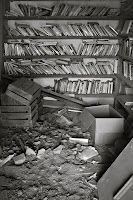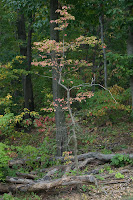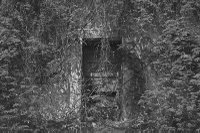 A set of Nambe-like metallic salt and pepper shakers (featuring shiny reflecting metallic surfaces), assorted pots and pans and formal serving trays, and the backdrop and decor of my in-laws' dining room (in Coral Gables, Florida), all mysteriously conspired - during the Thanksgiving break - to teach me a lesson on the art of making blurred distinctions. I mean this both literally - as in exploring (what for me) is an unusual range of bokeh-inducing f-stops (f~2.8; compared to the range I "normally" work in: f11 ~ f16) - and metaphorically - as in the lesson the "abstract experiments" I will describe below has taught me about the blurry distinction between "photography" and (more traditional forms of) "art."
A set of Nambe-like metallic salt and pepper shakers (featuring shiny reflecting metallic surfaces), assorted pots and pans and formal serving trays, and the backdrop and decor of my in-laws' dining room (in Coral Gables, Florida), all mysteriously conspired - during the Thanksgiving break - to teach me a lesson on the art of making blurred distinctions. I mean this both literally - as in exploring (what for me) is an unusual range of bokeh-inducing f-stops (f~2.8; compared to the range I "normally" work in: f11 ~ f16) - and metaphorically - as in the lesson the "abstract experiments" I will describe below has taught me about the blurry distinction between "photography" and (more traditional forms of) "art."
“In the sky, there is no distinction of east and west; people create distinctions out of their own minds and then believe them to be true.” - GAUTAMA SIDDHARTA (563-483 B.C.)
The context, and lucky trigger, for my lesson, was my (day-job-related) physical and mental exhaustion that I've accrued over the days and weeks before the Thanksgiving break - which effectively barred me from going outdoors with my camera, as I normally do when on vacation. I was simply too tired to go on any of my usual photo-safaris. But not too tired to pick up a camera, of course ;-) I took the normal mix of family photos, and photos of my in-laws' garden plants and flowers.
And then we had Thanksgiving dinner! The silverware was out, the serving trays were on display, and those precious Nambe-like salt and pepper shakers were teasing me with their compositional possibilities!
I spent the next few days playing with the macro lens I brought with me, Canon's 100/f2.8. This is the same lens I'd used previously for both my "Micro Worlds" and "Whorls" portfolios, and remains one of my favorite lenses to turn to when my muse keeps me indoors. I trained my lens on the reflections of objects in the dining room that appeared on the salt and pepper shakers as I moved them around perched atop one of my mother-in-law's metal serving trays.
 What I found was both a revelation and a source of illumination on the nature of photography and art (with a smattering of insight into the nature of life itself).
What I found was both a revelation and a source of illumination on the nature of photography and art (with a smattering of insight into the nature of life itself).
"Thought is creating divisions out of itself and then saying that they are there naturally." - DAVID BOHM
First, the revelatory part... since, at f~2.8, the macro lens renders everything with an extremely narrow depth of field, the "distinction" between otherwise separate objects is either difficult to discern or is effectively invisible. Indeed, different "things" are mostly blurred into fuzzy indistinct clumps of overlapping shapes and color. And, speaking of color... precisely because of the paucity of recognizable "things" - that normally provide the backdrop of "compositional primitives" with which a photograph is aesthetically organized - color becomes as integral a component of a composition as shape and tone (this, coming from a black and white photographer - hence a revelation!).
The resulting images of reflected objects are (almost absurdly) minimalist abstractions of fuzzy fields of overlapping colors. My usual argument for preferring not to use color is that my "eye" tends to focus on shape, tone, and texture alone. Color (at least in the context of this particular aesthetic approach) is thus unnecessarily intrusive, distracting, and - often - overbearing. In my post-Thanksgiving experiments, however, with texture virtually gone, and shapes and tones reduced to their bare essentials, color reasserts itself as an important aesthetic tool. In side-by-side comparisons between the color and black & white versions (not shown here), I strongly favor the color versions.
As for the illumination part...it is often argued that the fundamental difference between traditional art (such as watercolor) and fine-art photography is that where photographers must search for (and find visual approximations of) what they wish to print as a "photograph" (and thereby use to communicate some "idea" or "feeling" as photographer-artists), traditional artists create what they see in their mind's eye (or inspired by what they see). The artist intentionally adds things in his "mind's eye" to an initially blank canvas; the photographer intentionally wanders around the world looking for something "out there" to add to an initially data-lacking CMOS sensor (or undeveloped film) that the lens can record an image on. One adds information from within; the other adds information from without.
 But is that really the case? My post-Thanksgiving macro experiments reminded me that - on the deepest level - there is little if any meaningful distinction between what artists of any kind do. All artists create; that is what they do, and that is what describes how they behave. But it is the process that defines them; not the tools they use, not the methods they employ to create their finished artwork, not even the conventional "categories" that others use to label what kind of artists the world perceives them to be.
But is that really the case? My post-Thanksgiving macro experiments reminded me that - on the deepest level - there is little if any meaningful distinction between what artists of any kind do. All artists create; that is what they do, and that is what describes how they behave. But it is the process that defines them; not the tools they use, not the methods they employ to create their finished artwork, not even the conventional "categories" that others use to label what kind of artists the world perceives them to be.
"What is needed is ... to give up altogether the notion that the world is constituted of basic objects or building blocks. Rather one has to view the world in terms of universal flux of events and processes." - DAVID BOHM
The usual art / photography distinction is blurred by what I found myself doing with my camera to "create" my images (a few of which appear in this blog). Rather than simply moving my camera left, right, up, and down on my tripod "looking for pleasing compositions" - as I normally do when doing macro photography (and which, in particular, I employed for both the "Micro Worlds" and "Whorls" portfolios), I found myself also intentionally repositioning the metal tray on which the salt and pepper shakers were standing, intentionally moving various colored objects on the table that were reflected in the shakers and tray, intentionally moving objects on the adjacent walls, and intentionally changing the room lighting.
On the one hand, none of this is out of the ordinary, and - to a degree - is something that I, and all photographers regularly do. On the other hand, there is a crucial difference: in this case, I was making all of these changes not just so that I could find a pleasing composition (that would, as if by magic, appear before me); but because I deliberately wanted to create just the right combination of objects and light for a particular composition of color, shape, and tone - that I had previsualized in my mind's eye - to appear in my viewfinder! In short, I was using a camera, but I was creating the image as though I was a traditional artist!
To be sure, I had no brushes and was not using paint; but the effect - and, more importantly, the intent - was exactly the same. To make the distinction - or lack of one - even more self-evident, consider a simple thought experiment. Suppose I create an image, such as this one...
 ...in the way as I've described above: I use my macro lens set to f2.8, and deliberately and willfully create a local "environment" (consisting of a particular configuration of things, light, and color) previsualizing the image that forms in my viewfinder to look as it appears in the image above. I press the shutter, and process the file as I normally do (except skip the step of converting to black and white). Call the resulting image, image-A. Now suppose that I instead start with a paint program - say ArtRage (which, BTW, is a magnificent little program that does much of what more sophisticated and expensive programs do for a fraction of the cost: check it out!) - and paint the same image. I then grab my camera, take a shot, and again process as I normally do, winding up with image-B.
...in the way as I've described above: I use my macro lens set to f2.8, and deliberately and willfully create a local "environment" (consisting of a particular configuration of things, light, and color) previsualizing the image that forms in my viewfinder to look as it appears in the image above. I press the shutter, and process the file as I normally do (except skip the step of converting to black and white). Call the resulting image, image-A. Now suppose that I instead start with a paint program - say ArtRage (which, BTW, is a magnificent little program that does much of what more sophisticated and expensive programs do for a fraction of the cost: check it out!) - and paint the same image. I then grab my camera, take a shot, and again process as I normally do, winding up with image-B.
Here's the obvious question: are these images different in any meaningful way? And, if not, then why? Assuming I've acquired a modicum of painting skill before opening the paint program, let's for sake of argument accept that I've managed to create a passable doppelganger for Image-A. We can safely assume that - apart from some minor cosmetic differences - Image-A is essentially equivalent to Image-B; i.e., the two images are effectively the "same." But we must ask, why are they the same? Clearly, the processes that led to the two images are very different. In one case, an image has been photographed; in the other, it was created directly in a paint program. The constant in both cases, of course, is the artist, and the previsualized image the artist had "within" before initiating the creative process that leads to the physical creation of either of the two images.
Is the "artist" a photographer or is the artist a traditional artist? And does the distinction really matter in this case? On can also argue that the deliberate "repositioning of objects" to yield specific color-forms in the camera's viewfinder is merely a "complicated label" that designates a different kind of "brush" used to apply a different kind of "paint" to a different kind of "canvas" (albeit a more involved and complex one). Whichever way one argues, though, in the end, I'm left with the conviction that - at least in this case (of post-Thanksgiving macro experimentation) - I'm both photographer and artist, and I'm neither a "photographer" nor am am I an "artist."
So what am I, really? Ahh, we've now truly come back to basics. What else, but the blurred distinctions between the sounds of one hand clapping!
 "Whether you are going or staying or sitting or lying down,
"Whether you are going or staying or sitting or lying down, the whole world is your own self.
You must find out
whether the mountains, rivers, grass, and forests
exist in your own mind or exist outside it.
Analyze the ten thousand things,
dissect them minutely,
and when you take this to the limit
you will come to the limitless,
when you search into it you come to the end of search,
where thinking goes no further and distinctions vanish.
When you smash the citadel of doubt,
then the Buddha is simply yourself."
- DAIKAKU (Zen teacher)































